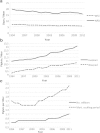A 25 years experience of group-housed sows-reproduction in animal welfare-friendly systems
- PMID: 24910081
- PMCID: PMC4061533
- DOI: 10.1186/1751-0147-56-37
A 25 years experience of group-housed sows-reproduction in animal welfare-friendly systems
Abstract
Since January 1 2013, group housing of sows has been compulsory within the European Union (EU) in all pig holdings with more than ten sows. Sows and gilts need to be kept in groups from 4 weeks after service to 1 week before the expected time of farrowing (Article 3(4) of Directive 2008/120/EC on the protection of pigs). The legislation regarding group housing was adopted already in 2001 and a long transitional period was allowed to give member states and producers enough time for adaptation. Even so, group housing of sows still seems to be uncommon in the EU, and is also uncommon in commercial pig farming systems in the rest of the world. In this review we share our experience of the Swedish 25 years of animal welfare legislation stipulating that sows must be loose-housed which de facto means group housed. The two most important concerns related to reproductive function among group-housed sows are the occurrence of lactational oestrus when sows are group-housed during lactation, and the stress that is associated with group housing during mating and gestation. Field and clinical observations in non-lactating, group-housed sows in Sweden suggest that by making basic facts known about the pig reproductive physiology related to mating, we might achieve application of efficient batch-wise breeding without pharmacological interventions. Group housing of lactating sows has some production disadvantages and somewhat lower productivity would likely have to be expected. Recordings of behavioural indicators in different housing systems suggest a lower welfare level in stalled animals compared with group-housed ones. However, there are no consistent effects on the reproductive performance associated with different housing systems. Experimental studies suggest that the most sensitive period, regarding disturbance of reproductive functions by external stressors, is the time around oestrus. We conclude that by keeping sows according to the pig welfare-friendly Directive 2008/120/EC, it is possible to combine group-housing of sows with good reproductive performance and productivity. However, substantially increased research and development is needed to optimize these systems.
Figures

Similar articles
-
Reproductive issues in welfare-friendly housing systems in pig husbandry: a review.Reprod Domest Anim. 2012 Aug;47 Suppl 5:51-7. doi: 10.1111/j.1439-0531.2012.02108.x. Reprod Domest Anim. 2012. PMID: 22913560 Review.
-
Aggression and cortisol levels in three different group housing routines for lactating sows.Acta Vet Scand. 2015 Feb 18;57(1):9. doi: 10.1186/s13028-015-0101-7. Acta Vet Scand. 2015. PMID: 25884361 Free PMC article.
-
Effects of group housing on reproductive performance, lameness, injuries and saliva cortisol in gestating sows.Prev Vet Med. 2018 Nov 15;160:10-17. doi: 10.1016/j.prevetmed.2018.09.026. Epub 2018 Sep 26. Prev Vet Med. 2018. PMID: 30388991
-
Animal board invited review: The need to consider emissions, economics and pig welfare in the transition from farrowing crates to pens with loose lactating sows.Animal. 2023 Sep;17(9):100913. doi: 10.1016/j.animal.2023.100913. Epub 2023 Jul 20. Animal. 2023. PMID: 37573640 Review.
-
Comparison between Single- and Group-housed Pregnant Sows for Direct and Indirect Physiological, Reproductive, Welfare Indicators and Gene Expression Profiling.J Appl Anim Welf Sci. 2021 Jul-Sep;24(3):246-259. doi: 10.1080/10888705.2020.1790369. Epub 2020 Sep 7. J Appl Anim Welf Sci. 2021. PMID: 32894989
Cited by
-
Pen Versus Crate: A Comparative Study on the Effects of Different Farrowing Systems on Farrowing Performance, Colostrum Yield and Piglet Preweaning Mortality in Sows under Tropical Conditions.Animals (Basel). 2023 Jan 8;13(2):233. doi: 10.3390/ani13020233. Animals (Basel). 2023. PMID: 36670773 Free PMC article.
-
Reproduction of group-housed sows.Porcine Health Manag. 2016 Jul 1;2:15. doi: 10.1186/s40813-016-0033-2. eCollection 2016. Porcine Health Manag. 2016. PMID: 28405441 Free PMC article. Review.
-
Current strategies for reproductive management of gilts and sows in North America.J Anim Sci Biotechnol. 2015 Jan 31;6(1):3. doi: 10.1186/2049-1891-6-3. eCollection 2015. J Anim Sci Biotechnol. 2015. PMID: 25838898 Free PMC article. Review.
-
Management practices related to the control of gastrointestinal parasites on Swedish pig farms.Porcine Health Manag. 2021 Jan 20;7(1):12. doi: 10.1186/s40813-021-00193-3. Porcine Health Manag. 2021. PMID: 33472698 Free PMC article.
-
Stress Biomarkers in Pigs: Current Insights and Clinical Application.Vet Sci. 2024 Dec 10;11(12):640. doi: 10.3390/vetsci11120640. Vet Sci. 2024. PMID: 39728980 Free PMC article. Review.
References
-
- DIRECTIVE 2008/120/EC of 18 December 2008 Laying Down Minimum Standards for the Protection of Pigs. [ http://eur-lex.europa.eu/LexUriServ/LexUriServ.do?uri=OJ:L:2009:047:0005...]
-
- EC, 2012. Questions and Answers on the Upcoming Ban on Individual Sow Stalls. Memo/12/280/Brussels, 26 April, 2012. [ http://europa.eu/rapid/press-release_MEMO-12-280_en.htm]
-
- Mul M, Vermejl I, Hindle V, Spoodler H. EU-Welfare Legislation on Pigs. Report 273. Lelystad: Wageningen UR Livestock Research; 2010.
-
- Kemp B, Soede NM. Reproductive issues in welfare-friendly housing systems in pig husbandry: a review. Reprod Domest Anim. 2012;47:51–57. - PubMed
-
- FAO 2012. Food and Agriculture Organization of the United Nations: Pigs and Animal Production. [ http://www.fao.org/ag/againfo/themes/en/pigs/production.html]
Publication types
MeSH terms
LinkOut - more resources
Full Text Sources
Other Literature Sources

